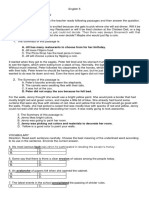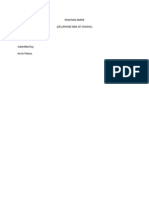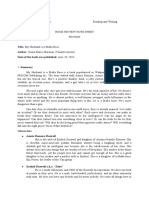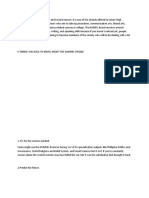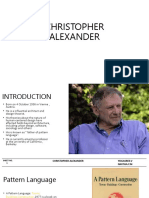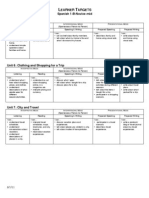Magkamag-Anak (Consanguineal or Affinal Relations), Magkapitbahay (Neighboring
Magkamag-Anak (Consanguineal or Affinal Relations), Magkapitbahay (Neighboring
Uploaded by
Kristina Pauline ObraCopyright:
Available Formats
Magkamag-Anak (Consanguineal or Affinal Relations), Magkapitbahay (Neighboring
Magkamag-Anak (Consanguineal or Affinal Relations), Magkapitbahay (Neighboring
Uploaded by
Kristina Pauline ObraOriginal Description:
Original Title
Copyright
Available Formats
Share this document
Did you find this document useful?
Is this content inappropriate?
Copyright:
Available Formats
Magkamag-Anak (Consanguineal or Affinal Relations), Magkapitbahay (Neighboring
Magkamag-Anak (Consanguineal or Affinal Relations), Magkapitbahay (Neighboring
Uploaded by
Kristina Pauline ObraCopyright:
Available Formats
Filipino Children in Family and Society: Growing Up in a Many-People Environment Hiromu Shimizu he o!
"ective o# thi$ pre$entation i$ to report on the $ocial environment in which children grow up in the Philippine$% o !e more $peci#ic& thi$ i$ a report on the characteri$tic$ o# the $ocialization proce$$ o# Filipino children who are !orn and !rought up in the manypeople environment !eyond the nuclear #amily& with complicated dyadic relation$ and variou$ parenting #igure$% he re#erence material$ ' have u$ed ()* concern the agalog people living in the central and $outhern area$ o# the i$land o# +uzon& !ut !a$ically the$e #inding$ will al$o apply to the group called lowland Chri$tian$% ),) HE F-M'+. C'/C+E -/0U12 HE CH'+2 'n the Philippine$ the nuclear #amily i$ the !a$ic #orm o# hou$ehold 3 a4aha$hi )56 ,&p%)758% - clo$er view o# the people in daily li#e& however& $how$ that the nuclear #amily i$ not a clo$ed& i$olated unit con$i$ting o# only the married couple and their unmarried children% 't ha$ #re9uent and intimate interaction$ with the #amilie$ living near!y% 't i$ not unu$ual to #ind elderly parent$ or elderly unmarried $i!ling$ o# the hou$ehold:$ head $till living together in the $ame hou$ehold% Even newlywed couple$ #re9uently live in the home o# the parent$ o# either the hu$!and or the wi#e% hey !uild a new hou$e a#ter one or two children are !orn& !ut even then they pre#er to !uild the hou$e within the compound o# the parent:$ hou$e or in the $ame neigh!orhood% here are no $et rule$ a!out whether they live with the hu$!and:$ parent$ or the wi#e:$ parent$% Stati$tic$ $how that the ;i$ayan and ;i4ol group$ tend to choo$e the wi#e:$ #amily and the agalog and 'locano group$ the hu$!and:$ #amily 3Holln$teiner <5=<& p%)>?8% ln either ca$e& however& the choice $eem$ to depend !a$ically on which #amily o##er$ !etter economic condition$& $uch a$ wealth& amount o# agricultural land& hou$ing& or "o! opportunitie$% 1o clear-cut di##erence$ can !e o!$erved !etween men and women& a$ the parent$: e$tate i$ divided e9ually among !rother$ and $i$ter$ 3 a4aha$hi )5<,& pp%)7@-778% ;e$ide$ children continuing to live in the parent$: hou$e or in the $ame compound a#ter marriage& there arc many in$tance$ o# relative$ living on ad"oining or near!y land% Ahen relative$ live in the $ame neigh!orhood or group together in one place& there i$ #re9uent vi$iting and $haring o# #ood among them% -ccording to Murray 3)5<@8& a local 4in group i$ #ormed in $uch a ca$e% hree relation$hip$ are #ormed $imultaneou$ly in thi$ group: magkamag-anak 3con$anguineal or a##inal relation$8& magkapitbahay 3neigh!oring relation$8% he$e com!ine to #ormed organic relation$hip that $urpa$$e$ the nuclearB #amily& which Murray $ay$ i$ C$omewhat li4e a unilineal group%C to 9uote #rom hi$ report: C-mong the 1orthern agalog a$ #ound in San '$idro& 1ueva Eci"a& there are corporate local 4in group$ compo$ed o# #amily-hou$ehold$% here i$ no agalog term #or $uch group$& !ut re$ident$ recognize their eDi$tence % % % % +ocal 4in group$ are the $upra #amilial unit$ within which all important day-to-day& #ace-to-#ace interaction occur$ 3particularly #or the very old and the very young8 % % % % -lthough component nuclear#amily hou$ehold$ are di$tingui$ha!le #rom one another in term$ o# $eparate roo#$& interaction pattern ma4e$ thi$ di$tinction le$$ clear at all pha$e$ o# the nuclear #amily:$
development % % % % Moreover& $ince the children !orn to #amily-hou$ehold$ !elonging to $uch a local 4in group tend at marriage to remain in the group& the local 4in group per$i$t$ over time% )n thi$ it i$ $omewhat li4e a unilineal groupC 3pp%,E& @>-@78% Ahile Murray 3)5<@8 $tate$ that neigh!or$ who do not have con$anguineal or a##inal relation$ are not mem!er$ o# thi$ local 4in group 3p@,8& he recognize$ the !a$i$ o# thi$ group a$ locality rather than de$cent 3p@?8% a4aha$hi 3)5<,8& who conducted a $urvey in ;ulacan in central +uzon& point$ out the importance to daily li#e o# a neigh!oring hou$ehold group& which i$ #ormed on the !a$i$ o# 4in$hip relation$ !ut al$o include$ non4in neigh!or$: -lthough all the people in the !arrio have a #riendly relation$hip& they do not have e9ual relation$ with everyone in the community% here i$ a much clo$er relation$hip in every a$pect o# daily living among tho$e who live within $houting di$tance o# each other% he$e group$ o# people who have #ace-to-#ace contact$ are called kapitbahay 3neigh!or$8% o u$e the word$ o# a #riend who live$ in ;aliwag town& kapitbahay are tho$e living within a $tone:$ throw% 'n the ca$e o# my village& in variou$ place$ in the paddy #ield$& there are $everal $lightly rai$ed plot$ o# land& called pulo 3meaning :i$land:8& $urrounded !y tree$ or !am!oo #ore$t$ where $everal to ten-odd hou$e$ are grouped together% 1ot all the people living in one pulo are con$anguineal nor a##inal relative$& !ut the relation$hip in each group i$ a very clo$e one% Mem!er$ o# the kapitbahay $pend their time $itting together and chatting day and night and it i$ al$o the kapitbahay mem!er$ who help in the $earch #or a lo$t carabao 3water !u##alo8% Ahen there wa$ a #uneral& the people who were providing the utmo$t a$$i$tance& $uch a$ in the 4itchen& were kapitbahay mem!er$% 't i$ al$o among the kapitbahay mem!er$ that the cu$tom o# the hou$ewi#e !orrowing #ood and daily living commoditie$ #rom #riend$ and neigh!or$ 3humingi8 i$ mo$t #re9uently o!$erved% hi$ kapitbahay i$ truly a primary group $upported !y #eeling$ o# $olidarity and unity& and it i$ where $ocial regulation$ in daily living are $tronge$tC 3p%)==8% 't i$ 9ue$tiona!le whether the group that Murray call$ the local 4in group and a4aha$hi call$ the neigh!oring hou$ehold group i$ really a $ocial group% hi$ group ha$ no mem!er$hip rule$ nor #iDed !oundarie$ and the way it i$ #ormed di##er$ according to the $ituation% 't may !e more appropriate to call thi$& a$ Faut 3)5=78 doe$& a $ocial grouping or a #amily circle o# interwoving dyadic relation$% Furthermore% the 4ind o# #amily group having a clearly delineated #ramewor4& a$ reported !y Murray and a4aha$hi& doe$ not eDi$t in every agalog region% However& $ince thi$ report doe$ not aim to pre$ent a $tudy o# Filipino $ocial $tructure o# analytical concept$& ' only wi$h to point out and $tre$$ the #act that the nuclear #amily in thi$ ca$e i$ not a clo$ed and i$olated unit !ut part o# a mom open relation$hip% Some re$earcher$ point to the eDi$tence o# the eDtended #amily a$ a group that tran$cend$ the nuclear #amily and it$ $igni=cant role in child rearing practice$ 3c#% -rellano-Carandang )5<5& Guinto$ )5<5& and Gui$um!ing )5=>8% FE- U/ES 0F CH'+2 /E-/'1G
- newlywed couple will rarely live in i$olation among complete $tranger$% hey will u$ually live clo$e to the parent$ o# either the hu$!and or wi#e& within the $ame hou$e or in a $mall hou$e !uilt near the parent$: hou$e% hey will !egin their new li#e together in a place where parent$& uncle$ and aunt$& !rother$ and $i$ter$& and cou$in$ are grouped together% hey will al$o a$$ociate with #amilie$ living in the neigh!orhood practically a$ though they were relative$& even i# they are not con$anguineally or a##inally related% Ahen one con$ider$ the growing-up proce$$ o# Filipino children within thi$ networ4 o# clo$e human relation$& the #ollowing can !e pointed out a$ e##ect$ o# the $urrounding environment% Fir$t o# all& the pre$ence o# many parenting #igure$& or $urrogate$ #or the mother and #ather& $uch a$ grandparent$& uncle$ and aunt$& and older cou$in$& ha$ the mo$t $igni#icance% he re$pon$i!ility #or child rearing doe$ not re$t $olely on the child:$ parent$% C-$ $oon a$ the child can !e carried out$ide the hou$e& he generally pa$$e$ #rom one hand to another -- #ondled& 4i$$ed& pinched and care$$ed !y almo$t everyoneC 3Hocano )5<7& p% E)8% here i$ alway$ $omeone clo$e at hand to ta4e care o# the child when the mother ha$ to go to wor4 or leave the hou$e on $ome errand% % Aomen are eDtremely active in Filipino $ociety& in politic$& economic$& admini$tration& education& and many other #ield$& and the $tatu$ o# women i$ generally high% -lthough the #act that $ociety ha$ a climate that can accept the $ocial activity o# women i$ a very important !ac4ground #actor& the #act that women can ea$ily #ind $omeone to ta4e over their child rearing and hou$ewor4 i$ al$o a ma"or #actor% Aealthy and middle-cla$$ #amilie$ in the citie$ employ hou$emaid$ at low wage$I !ut when women o# the general populace& or women living in rural village$ or $maller citie$ go out to wor4 in retail !u$ine$$ or a$ civil $ervant$ or teacher$ or when they go out to do #arm wor4 with their hu$!and$& even they can ea$ily #ind $omeone 3$uch a$ the children:$ grandparent$ or an uncle or aunt8 to ta4e care o# their children% '# a daughter !ecome$ an unwed mother or i$ $eparated #rom her hu$!and& the grandparent$ will !ecome parent $urrogate$ #or the child or an uncle may !ecome a #ather $urrogate% Even i# the #amily i$ angry at the daughter and will not $pea4 to her& the child i$ #ully accepted into the #amily and treated warmly 3Guinto$ )5<5& p%=)8% he $econd characteri$tic o# the child:$ $ocialization proce$$ in the Philippine$ i$ that the child i$ ta4en care o# #or a long period o# time& owing to the #act that& a$ $een in the primary characteri$tic& there are many adult$ or elderly people who can !ecome parenting #igure$% Even when the neDt child i$ !orn and the mother:$ attention i$ #ocu$ed on the new!orn !a!y& there i$ no lac4 o# parenting #igure$ to ta4e care o# the older child and there#ore no need #or the child to !ecome independent immediately% '# the child cannot carry out $uch activitie$ a $ !athing& dre$$ing& or clean$ing a#ter elimination independently& there i$ alway$ $omeone near!y to help% Even when the child can do tho$e thing$ unaided& it i$ not unu$ual #or $omeone to help anyway% Furthermore& when the child ha$ matured to a certain degree& he or $he will have to loo4 a#ter younger !rother$ and $i$ter$& and cou$in$ in the $ame way% 'n general& there are no rule$ or re9uirement$ in the Philippine$ regarding what the child mu$t !e a!le to do at a certain age% CMaturation
i$ a lei$urely proce$$& not to !e accelerated !y parental encouragement or too deli!erate training% he child will eventually come around to it when he under$tand$C 3Manalang )5<>& p%7,8% 't i$ neither unu$ual nor em!arra$$ing #or one child to !e una!le to do at the age o# #our what another can do at the age o# two% Furthermore& it i$ $trongly !elieved that the longer the parent$ $leep with the child the longer will the child #eel a##ection #or the parent$ and #amily a#ter growing up and the longer will the child #eel a##ection #or the parent$ and #amily a#ter growing up and the longer will the child $tay clo$e to the #amily% here#ore& the child i$ not trained to $leep alone 3Guthrie and Haco!$ )5<=& pp%57-5<I Guinto$ )5<5& p%=,8% he third characteri$tic i$ that the child ha$ very little $tre$$ or #eeling$ o# #ru$tration& !ecau$e there wa$ many parent $urrogate$ to $ati$#y hi$ or her de$ire$% Even i# the child:$ parent$ do not $ati$#y hi$ de$ire$& $omeone he can $elect #rom among the clo$e relation$hip$& $uch a$ the grandparent$& uncle$& or aunt$& will realize hi$ wi$he$% Ahen the mother ignore$ or re#u$e$ to indulge the child:$ wi$he$& it will not !e $uch a great p$ychological $train on the child% Even i# the child ha$ #eeling$ o# $orrow& anger& or re!ellion& $uch #eeling$ are temporary and never long la$ting& and there will !e no accumulation o# great $tre$$ that may change the child:$ character% 't i$ pro!a!ly !ecau$e there i$ $o little $tre$$ o# thi$ 4ind the $o-called "uvenile delin9uency in the Philippine$ i$ rarely a$$ociated with great violence 3Guinto$ )5<5& p% =,8% 0!$erving the $ocialization proce$$ o# the child in the Philippine$& the characteri$tic$ may !e de$cri!ed& in a word& a$ eDtremely dependent% he concept o# dependency ha$ negative connotation$& $uch a$ mental or phy$ical wea4ne$$& !ut in the Philippine$ it doe$ not have a negative meaning% 2ependency mu$t !e under$tood a$ a relation$hip that !egin$ with the recognized relation$hip that the child #orm$ with the adult$ in the environment and eventually eDtend$ into a mutually dependent& cooperative relation$hip in which all the mem!er$ depend on each other and help each other% -t lea$t among #amily mem!er$& neigh!or$& #riend$& and ac9uaintance$& living in a relation$hip o# mutual cooperation and a$$i$tance i$ an important $ocial philo$ophy that doe$ not changed& no matter what age one attain$& and i$ con$idered an ideal way o# $ocial li#e% 'n their di$cu$$ion o# dependency and the child:$ $ee4ing o# nurturance& which eDtend$ into ha!itual $uccoring adult$& GuthrieJ he child $ee4$ help even when he doe$ not need it a$ a !id #or attention and a##ection % % % % i# he pic4$ the right time& he get$ it% '# not& the $ituation i$ plain enough or he i$ there& he i$ called on to help% He i$ not $o much an individua) a$ he i$ a part o# a #amily who$e older mem!er$ are hi$ $upport and who$e younger mem!er$ are hi$ re$pon$i!ility% /e$pon$i!ilitie$ are not pu$hed on him when he reache$ a certain age% 'n$tead he grow$ into them& gaining the nece$$ary $4ill$ a$ he participate$ in the day-to-day activitie$ o# thee #amily%%%% From childhood he learn$ to en"oy !eing ta4en ca re o# and realize$ that he can ma4e other$ happy !y !eing dependent on them% here i$ no age when a child i$ eDpected to leave home nor an age when he i$ eDpected to !ecome #ully $el#-
reliant% Even marriage mean$ that each o# the coup)e ha$ a nud !rought up in the many-people hom $upport will !e #orthcoming and help may !e re9uired 3pp%#@>& 5<-5E8% C012' '01S 0F - G002 CH'+2 he #act that the child ha$ multiple choice$ !e$ide$ the parent$ #or receiving love and protection ha$ many po$itive a$pect$ #or !oth the parent$ and the child% he child& however& doe$ not receive $uch #avor$ one-$idedly% he child al$o ha$ to carry out the role and !ehavior that the adult$ in hi$ environment eDpect o# him% 'n the Philippine$ a child i$ a !le$$ing #rom God and i$ con$idered proo# that the #amily i$ living in the grace o# God 3Holln$teiner )5<?& p%@)8% -t the $ame time& #or the parent$ the child i$ a #orm o# inve$tment and $ecurity #or old age% For thi$ rea$on it i$ generally !elieved that the greater the num!er o# children and the larger the #amily& the happier the #amily will !e% he government i$ conducting variou$ #amily planning campaign$ to reduce the annual population growth rate& which i$ clo$e to three percent& !ut with very little e##ect !ecau$e /oman Catholic doctrine #or!id$ it 3the people are rarely con$ciou$ o# the #act that it i$ #or!idden8 !ut !ecau$e o# the $trong de$ire to have many children% Even i# the wi#e attend$ lecture$ on #amily planning and ta4e$ an intere$t in !irth control& it may !e di##icult to practice !ecau$e the hu$!and& who thin4$ many children to !e proo# o# manline$$& might !e uncooperative or the parent$& who !elieve a large #amily ideal& might !e again$t it% he average num!er o# children !orn alive per couple i$ pre$ently a!out 7%> 3)5<? cen$u$8% he #igure i$ lower in Metro Manila and other ur!an area$ and higher in rural area$% 't i$ not unu$ual to #ind couple$ with more than ten children% he many children !orn in thi$ environment have variou$ important role$ to play in #amily li#e according to their $tage o# maturation% Ahen the child i$ $till a !a!y& he i$ the center o# the love and attention o# the parent$ and other adult$ and i$ eDpected to provide laughter and "oy through hi$ $mile and ge$ture$% Aeaning and toilet training are not a$ #orced or early a$ in the United State$ or Hapan and have even !een de$cri!ed a$ permi$$ive 3Manalang )5<>& pp% 7,-7@8& !ut it i$ not important in the child:$ development that he !ecome a!le to ta4e care o# him$el#% /ather& it i$ con$idered more important that the child learn$ to re$pond actively to the people $urrounding him and to communicate intimately with them% Eventually& the child mu$t ta4e care o# younger !rother$ and $i$ter$ and carry out $uch daily ta$4$ a$ drawing water% ;oy$ mu$t eventually help with their #ather:$ wor4 and loo4 a#ter dome$tic animal$ and girl$ mu$t help their mother$ with hou$ewor4 and $hopping% 'n the Philippine$ the world o# adult$ and the world o# children are not $eparated and the children a$$ume certain role$ in the #amily that they are capa!le o# a$$uming in accordance with their age$% he children learn a$ they help the adult$ in their wor4& !y imitating what they o!$erve or !y receiving $peci#ic training% here are there#ore very #ew ta$4$ or activitie$ #rom which the adult$ will eDclude the children% Even at !edtime& there i$ no $et time !eyond which the children are not allowed to $tay awa4e and they are allowed to $tay up late with the adult$ i# they wi$h to do $o% However& the children are
u$ually eDhau$ted !y the day:$ activitie$ and will go to $leep !e#ore the adult$% Even i# a $eparation into the world o# adult$ and the world o# children were po$$i!le& in the Philippine$ the two world$ would eDi$t in a relation$hip o# interaction& $uper impo$ed over each other% he child:$ growth& there#ore& i$ not a proce$$ in which the child !ecome$ an adult through a $e9uence o# rite$ o# pa$$age& receiving a clear-cut $tatu$ in each $tage o# development% 't i$& rather& one in which the child& with the eDception o# certain rite$ -$uch a$ entering elementary $chool or Con#irmation -- a$$ume$ the world o# adult$ little !y little in accordance with hi$ phy$ical growth and gradually enter$ the adult world% -t the $ame time& he learn$ the value$ and !ehavior pattern$ o# the adult$% /eturning to a previou$ point o# di$cu$$ion& in a li#e $tyle in which the #amilie$ o# relative$ live clo$e to one another and #riendly relation$ am maintained with neigh!or$ who are not relative$& there are many parent $urrogate$ !ut there are at the $ame time a great num!er o# children% he child ha$ many choice$ regarding parenting #igure$& !ut at the $ame time the child i$ not the $ole #ocu$ o# the love and attention o# each adult or elderly per$on% here are alway$ $everal competitor$& $uch a$ $i!ling$ clo$e in age or cou$in$ o# the $ame age% 'n $uch compleD relation$hip$& even a child cannot alway$ demand attention or depend unconditionally on the people in hi$ environment: Kery early the child learn$ to relate at many di##erent level$ to $everal di##erent admit$ and& i# nece$$ary& learn$ to manipulate $ituation$& to weave hi$ way through to get hi$ own $peci#ic need$ met& and hi$ uni9uene$$ ac4nowledged% He ha$ to #ind a place o# hi$ own in thi$ many people environment& or clo$e hi$ value may not !e recognized%%%% l# one con$ider$ the compleDity o# the com!ination$ o# interrelation$hip$ involvedI one cannot !ut marvel at how $moothly and rhythmically thi$ machinery o# the Filipino #amily can operate in $pite o# all odd$LC 3-rellano-Carandang )5<5& p%><>8% 'n order to #ul#ill one:$ de$ire$ or o!"ective$& one #ir$t o# all !e accepted !y other$ and maintain clo$e and #riendly relation$ with them% CAith many people living in a clo$e phy$ical and $ocial relation$hip& the handling o# ho$tility i$ o# crucial importance% - good deal o# empha$i$ i$ placed on the a!ility to avoid potentially angry $ituation$C 3Guthrie and Haco!$ )5<=& p%,?,8% here#ore& a$ +ynch 3)5<@a8 empha$ize$& the !uilding o# C$mooth interper$onal relation$C i$ indi$pen$a!le #or the realization o# C$ocial acceptance&C the mo$t important motivating #actor in the !ehavior o# the Filipino$ 3pp%E58% Filipino children are indulged !y many parenting #igure$ during the early in#ant period& !ut once they reach a certain developmental $tale they are taught not to !e $el#-centered or to try and have their own way in everything& !ut to alway$ !e con$iderate o# other #amily mem!er$ and all the other people in the environment% he child i$ repeatedly told that other people have li4e$& di$li4e$& and de$ire$ "u$t a$ he doe$ and that i# a con#lict o# intere$t $hould ari$e he $hould alway$ !e the one to give in to other$% he child thu$ learn$ at a relatively early $tage to re#rain #rom a$$erting hi$ ego and that he $hould not try to pu$h hi$ demand$ through the end% he child i$ al$o taught that other people have di##erent character$ and per$onalitie$ "u$t a$ he ha$ di##erent ta$te$ and de$ire$& and that
he $hould !e a!le to get along with all type$ o# people% 'n order to do thi$& he $hould !e care#ul a!out hi$ attitude and language $o a$ not to anger& hurt& or annoy the other party% Even when he #eel$ uncom#orta!le or angry he $hould not let the other party detect it !y letting it $how in hi$ #acial eDpre$$ion% So he mu$t $mile when the $ituation re9uire$ it even when he i$ not amu$ed& and pretend to !e calm even when he #eel$ violent rage% re!elliou$ attitude $hould !e avoided more than anything el$e and i$ $trongly $uppre$$ed% hu$& the $ocial environment in which Filipino children grow up nip$ an aggre$$ive attitude in the !ud and orient$ the child:$ development and character #ormation toward getting along and cooperating with other$% 'n other word$& re$pecting the emotion$ and #eeling$ o# other$& and $uppre$$ing one:$ own anger or di$plea$ure #or the $a4e o# $mooth interper$onal relation$& i$ valued more than anything el$e% he child mu$t learn the art o# $ocia!ility in hi$ own way and play the role o# the good child% 'n concrete term$ thi$ mean$ not only that the child mu$t not argue or #ight !ut al$? that the child mu$t avoid getting into ten$e $ituation$ that could lead to argument$ or #ight$% Ahen the child lo$e$ hi$ temper or rai$e$ hi$ voice in anger& $uch !ehavior i$ regarded a$ re#lecting the !ad character or di$po$ition o# the whole #amily% Even when the child i$ angry he mu$t not tal4 !ac4 and mu$t alway$ remain cool and compo$ed and a$$ume a #riendly attitude% Ahen he cannot do $o& he can& #or eDample& cry or u$e $ome other peace#ul method o# eDpre$$ion to $how the other party or the adult$ in the environment how hurt or angry he i$ and thu$ try to receive their protection% EMP-1S'01 -12 M-1'PU+- '01 0F 2.-2'C /E+- '01S he diver$e human relation$ that $urround the child are not limited to relative$ and ac9uaintance$ living in the $ame ground$ or neigh!orhood% -$ the neDt !a!y i$ !orn and the child retreat$ #rom the center o# attraction& the circle o# attention with which he ha$ #re9uent contact$ will grow% He will gradually a$$ume clo$er contact$ with playmate$& people in the $ame village 3kababaryo8& relative$ living in other area$& godparent$ with whom he will a$$ociate through the compadre $y$tem& and $o #orth% Ahen one meet$ Filipino people& one i$ immediately $truc4 !y the $trength o# their #amily !ond$ and !y the great num!er o# relative$ they $eem to have% 'n variou$ daily-li#e $ituation$ it i$ not unu$ual to !e introduced to one per$on a#ter another and to #ind that they are related% 'n the Philippine$& the third cou$in$ o# the ego and the $pou$e& that i$& the de$cendant$ o# the $i!ling$ o# the great-grandparent$ are u$ually recognized a$ relative$% 'n $ome in$tance$ the #ourth or even more remote cou$in$ are recognized a$ relative$% Since the average nuclear #amily $ize i$ $even to eight mem!er$& the num!er o# relative$ $well$ to tremendou$ proportion$ !y geometric progre$$ion% -ccording to the calculation$ o# one $ociologi$t& one Filipino per$on will have three hundred relative$ during hi$ li#etime& even !y the mo$t mode$t e$timate$ 3Marilag )5==8% 'n actual daily li#e& however& it i$ impo$$i!le to maintain e9ually clo$e relation$ with $uch a great num!er o# relative$% he actual num!er with whom one can a$$ociate and maintain clo$e and #re9uent contact$ will !e much $maller% he relative$ with whom one ha$ intimate relation$ are not nece$$arily determined !y $et rule$& $uch a$ the degree o#
con$anguinity& !ut !y one:$ per$onal ta$te$ and voluntary $election& !a$ed on how well one get$ along with them& proDimity o# location& economic merit& and $o #orth% hi$ create$ what i$ 4nown in $ocial anthropology a$ a Cper$onal 4indred:: he per$onal 4indred i$ a $ocial category con$i$ting o# an individual$ circle o# relative$ or that range o# a per$on:$ relative$ accorded $pecial cultural recognition% 't i$ not a clearly delineated group& $uch a$ a lineage o# de$cendant$ o# a particular ance$tor& !ut i$ an ego-centered circle o# con$anguineal 3and a##inal8 relative$% he dyadic relation$hip o# ego with each relative i$ not #iDed and unchanging% Ahen the individual i$ on !ad term$ with a relative& he $top$ a$$ociating with him regardle$$ o# the degree o# con$anguinity& while a di$tant relative !ecome$ an important mem!er o# the circle i# he live$ near!y and i$ on #riendly term$% (@* he 4indred o# the parent$ or the circle o# relative$ play$ an eDtremely important role in the growing up and $ocialization o# the child% Faut 3)5=78 call$ thi$ #orm o# grouping that occur$ #reely& according to the will and ta$te$ o# the individual& the Cprinciple o# contingencyC and eDplain$ it a$ #ollow$: C't i$ my hypothe$i$ that $ocial grouping$ -- not $ocial group$ in the $en$e de#ined a!ove -- are con$tantly changing their !oundarie$ and dimen$ion$ in agalog $ociety a$ $ucce$$#ul& un$ucce$$#ul& and accidental activation o# mode$ o# interaction create& $trengthen& or wea4en $ocial !ond$ o# o!ligation% Fin$hip and de$cent act mo$tly a$ point$ o# departure rather than eliminating $tricture$C 3p% =8% -nother important #actor in the development and $ocial relation$ o# the Filipino child i$ the ritual 4in$hip called the compadre $y$tem% hi$ i$ a $y$tem o# e$ta!li$hing ritual parent-child relation$ a$ godparent-godchild through the !apti$m ceremony o# the /oman Catholic religion% Ahen a child i$ to !e !aptized& the parent$ a$4 Catholic relative$ or #riend$ to !ecome the child:$ godparent$& regardle$$ o# marital $tatu$& $ince it i$ not re9uired that godparent$ !e married% ' have !een a$4ed !y #riend$ on $everal occa$ion$ to !ecome godparent& even though learn not a Catholic% 'n the Philippine$ the religiou$ $igni#icance o# e$ta!li$hing a ritual parent i$ to have $omeone to a$$ume the role o# guardian& to provide guidance $o that the child will grow up to !e a devout Catholic% he godchild 3inaanak8 i$ $uppo$ed to $how the god#ather 3ninong8 and godmother 3ninang8 the $ame re$pect and o!edience that he mu$t $how to hi$ parent$& and the godparent$ are eDpected to provide guidance and care& particularly in matter$ o# religion% -ctually& however& $ecular and $ocial re$pon$i!ilitie$ $eem to outweigh religiou$ dutie$% For eDample& the godparent$ are eDpected to !uy the godchild clothe$ #or the !apti$m and to provide remuneration to the church and other congratulatory gi#t$% he godparent$ al$o continue to give gi#t$& $uch a$ at Chri$tma$& and continue to loo4 a#ter the child in variou$ way$% he compadre $y$tem wa$ e$ta!li$hed #or the !etter development o# the child and it play$ a certain role& !ut actually it i$ the relation$hip !etween the godparent$ and the !iological parent$& centering on the child that i$ more important% he compadre $y$tem #unction$ a$ a way B o# ma4ing more #ormal !ond o# a clo$e #riend$hip& or o# drawing di$tant relative$ clo$er together& in other word$& o# ma4ing certain clo$e relation$ even-clo$er% he
godparent$ and !iological parent$ call each other kumpare& in the ca$e o# men& and kumare& in the ca$e o# women& and maintain an eDtremely clo$e a$$ociation in variou$ a$pect$ o# daily li#e% hey con$tantly provide mutual a$$i$tance& $uch a$ helping each other in #arm wor4& lending each other commoditie$& and $haring #ood% Ahen a compadre relation$hip i$ #ormed !etween two #amilie$ o# di##erent $ocio-economic $tatu$e$& it wor4$ to e$ta!li$h or $trengthen the $o-called patron-client relation$hip% Furthermore& although their $ocial $igni#icance i$ not a$ great a$ that o# the godparent$ at the time o# !apti$m& the $pon$or$ or witne$$e$ at the con#irmation and wedding ceremonie$ al$o #orm ritual parent-child relation$ with the child and are al$o called ninong& ninang& kumpare& and kumare% he godparent$ at the !apti$m are not re$tricted to one couple& and other CgodparentC #igure$ may !e cho$en $eparately #or the con#irmation and wedding% he child thu$ ha$ not only the relative$ and neigh!or$ !ut al$o the godparent$ in the compadre $y$tem with whom he ha$ clo$e relation$hip$% he parent$ will !e a!le to have at lea$t three $et$ o# Cgodparent$C #or one child 3at !apti$m& con#irmation and wedding8 and can choo$e di##erent $et$ o# Cgodparent$C #or each child& and will thu$ !e a!le to #orm ritual 4indred relation$ with a large num!er o# people% he$e ritual 4in$#ol4 com!ine with the actual relative$& who are numerou$ to !egin with& to ma4e 4indred relation$ in Filipino $ociety unimagina!ly compleD and intricate 30hno )5<E& pp% ,>?->,I a4aha$hi )5<,& pp%)=?-=,8% he $ocialization proce$$ o# Filipino children growing up in $uch open& complicated and diver$e relation$hip$ may !e $ummarized a$ a proce$$ o# learning the art and !ehavior pattern$ o# maintaining& $trengthening and eDtending the$e relation$hip$% 'n the Philippine$& a$ compared with Hapan& the #ormation o# group$ !a$ed on ba& that i$& a $ituational po$ition in a given frame 3$ee 1a4ane )5<?8& i$ not $o $trong& and the individual:$ per$onal 4indred& or variou$ circle$ or networ4$ o# people #ormed !y dyadic relation$& have an important #unction in $ocial li#e% -$ +ynch 3)5<@=8 empha$ize$: Every individual ha$ a $ocial univer$e which i$ di$tinctively hi$ own& con$tantly changing in $ize and content& it$ mem!er$ playing variou$ and o#ten multiple role in hi$ regard% Each $uch role promi$e$& in the a!$tract& more or le$$ $upport to the central #igure& and i$ empowered to demand in return a greater or $maller $hare o# hi$ loyalty and energie$% 0ne i$ $urrounded at every moment& in other word$& !y people who are potentially or in #act hi$ allie$& people he can count on to a greater or $maller degreeC 3 p%<> 8% he importance o# Filipino $ocial li#e a$ well a$ the $ocialization proce$$ o# children in the Philippine$ there#ore lie$ in the awarene$$ o# each per$on that he or $he i$ $ituated in interwoven diver$e human relation$& and particularly in the awarene$$ that each dyadic relation mu$t !e maintained alway$ in good term$& $o that the individual can depend on it when the need ari$e$% he$e relation$ are not #iDed and unchanging once they are e$ta!li$hed& and the !ond may !rea4 naturally unle$$ the $ocial di$tance o# the two per$on$ i$ con$tantly narrowedJ
Such !ehavior pattern$ a$ pakikisama 3conce$$ion& giving in& #ollowing the lead or $ugge$tion o# other$8& euphemi$m& the u$e o# go-!etween$& and utang na loob 3a de!t in$ide one$el#8 are indi$pen$a!le method$ o# realizing C$mooth interper$onal relation$%C For !ehavior that depart$ #rom the$e accepted norm$& the concept o# hiya 3Cthe uncom#orta!le #eeling that accompanie$ awarene$$ o# !eing in a $ocially unaccepta!le po$ition& or per#orming a $ocially unaccepta!le actionC8 act$ a$ an inhi!itory #orce% (>* C01C+U2'1G /EM-/FS 'n Children of Six Cultures: A Psycho-Cultural Analysis 3)5<78& ;eatrice ;% Ahiting and Hohn A%M% Ahitting have pre$ented an intere$ting report o# $iD team$ o# #ield wor4er$ who conducted detailed o!$ervation o# children in $iD di##erent $ocietie$ and compared and $tati$tically analyzed their $urvey re$ult$% he $iD di##erent culture$ are: aira 3northea$t coa$t o# 04inawa8& Fhalapur 3northern 'ndia8& 1yan$ongo 3we$tern Fenya8& HuDtlahuaca 3we$tern highland o# the MeDican $tate o# 0aDaca8& 0rchard own 31ew England& U%S%8& and arong 3northwe$t +uzon in the Philippine$8% he Ahiting$ have pre$ented data and conclu$ion$ #ull o# valua!le $ugge$tion$ #or under$tanding !oth the relative po$ition o# Filipino children in $uch a tran$-cultural compari$on and the characteri$tic$ o# their $ocial !ehavior% ' there#ore would li4e to re#er to and di$cu$$ their $tudy% a4ing the premi$e that Ncultural #eature$ $uch a$ the economy& $ocial $tructure& $ettlement pattern& and hou$ehold and #amily organization pre$uma!ly determine the learning enrivonment$ in which children are !rought up& thu$ in#luencing their !ehaviorO 3p% ==8& the Ahiting$ cla$$i#y the children in each culture into twelve !ehavior type$: act$ $ocia!ly& in$ult$& o##er$ help& reprimand$& $ee4$ dominance& $ee4$ help& $ugge$t$ re$pon$i!ly& o##er$ $upport& $ee4$ attention& a$$ault$ $ocia!ly& touche$& a$$ault$%
You might also like
- The Nativist ApproachDocument10 pagesThe Nativist ApproachDzulfikar LailiNo ratings yet
- Trends, Networks, and Critical Thinking in The 21 CenturyDocument27 pagesTrends, Networks, and Critical Thinking in The 21 CenturyYessa Mhay EmpreseNo ratings yet
- Hand Out No 2Document1 pageHand Out No 2Angelica NavarroNo ratings yet
- Week 3 Activity Personal Development - CostaDocument1 pageWeek 3 Activity Personal Development - CostaIrish Jewelle Costa100% (1)
- A. Jill Has Many Restaurants To Choose From For Her BirthdayDocument3 pagesA. Jill Has Many Restaurants To Choose From For Her Birthdayshincee23No ratings yet
- ENG - ACAD (Grade 12)Document8 pagesENG - ACAD (Grade 12)Joseph Gil Rosaban BandoyNo ratings yet
- Communication Strategy: TerminationDocument4 pagesCommunication Strategy: TerminationGerald Estiaga100% (2)
- Polgov Module 7Document28 pagesPolgov Module 7Keneth NagumNo ratings yet
- Oral Communi in Contex Cation T: Module No. 1 Nature, Functions and P Communicatio Rocess of NDocument48 pagesOral Communi in Contex Cation T: Module No. 1 Nature, Functions and P Communicatio Rocess of Ndhebie tioloNo ratings yet
- Filipino Children in Family and SocietyDocument21 pagesFilipino Children in Family and Societynino ranoaNo ratings yet
- Portfolio Output n9Document6 pagesPortfolio Output n9Regina BaltasarNo ratings yet
- HG Mod1 Q1Document1 pageHG Mod1 Q1MichelJoy De GuzmanNo ratings yet
- Lesson 3: Testimonio: Testimonio, Which Traces Its Origin To Autobiographical LiteratureDocument1 pageLesson 3: Testimonio: Testimonio, Which Traces Its Origin To Autobiographical LiteratureWendy BustamanteNo ratings yet
- Critical Approaches Task 1Document2 pagesCritical Approaches Task 1ZiarineNo ratings yet
- AbundanceDocument25 pagesAbundanceMyke MicabaloNo ratings yet
- Homeroom Guidance: OutputsDocument13 pagesHomeroom Guidance: OutputsSanji TapiaNo ratings yet
- Patterns of Development in Writing Across Disciplines: Reading and Writing SkillsDocument4 pagesPatterns of Development in Writing Across Disciplines: Reading and Writing SkillsMark Give De LeonNo ratings yet
- English For Academic and Professional Purposes: Name: DateDocument2 pagesEnglish For Academic and Professional Purposes: Name: DateMacky Diago0% (1)
- Name:Winston L. Murphy Grade/Section:G11-MMDocument3 pagesName:Winston L. Murphy Grade/Section:G11-MMWinston MurphyNo ratings yet
- CW Module7 (Finals)Document15 pagesCW Module7 (Finals)MarvelynFranciscoLagamoNo ratings yet
- ReflectionDocument3 pagesReflectionrodel valdez100% (1)
- Amancio 12 STEM A UCSP ACTIVITIES 4th Quarter OriginalDocument6 pagesAmancio 12 STEM A UCSP ACTIVITIES 4th Quarter OriginalamancioNo ratings yet
- 21ST Century Q2 M1 L3 Justine MimayDocument5 pages21ST Century Q2 M1 L3 Justine MimayMark Kenneth CastilloNo ratings yet
- What's More: Career Decision MakingDocument4 pagesWhat's More: Career Decision MakingJonrheym RemegiaNo ratings yet
- Concept PaperDocument2 pagesConcept PaperAngelie Bocala CatalanNo ratings yet
- Second Quarter - Week 3: English For Academic and Professional PurposesDocument12 pagesSecond Quarter - Week 3: English For Academic and Professional PurposesGarry QuezonNo ratings yet
- Concept PaperDocument13 pagesConcept Papermarycristdamgo332No ratings yet
- Guidance Modules 1-4Document14 pagesGuidance Modules 1-4ely sanNo ratings yet
- I. Trends and Fads: TREND - Generally A Direction Which Tells That Something Is Developing or Changing. inDocument4 pagesI. Trends and Fads: TREND - Generally A Direction Which Tells That Something Is Developing or Changing. inEllen CelebradosNo ratings yet
- 21st Cen LAS1 Literature of Visayas-Short story-ABM-G11-St - Catherine-Macaday, Venze Adrianne D.Document3 pages21st Cen LAS1 Literature of Visayas-Short story-ABM-G11-St - Catherine-Macaday, Venze Adrianne D.Venze Adrianne Damasco M100% (1)
- Should Homework Be MandatoryDocument3 pagesShould Homework Be Mandatoryzettevasquez8No ratings yet
- Applied Social Sciences - 062708Document25 pagesApplied Social Sciences - 062708Eldrick CortezNo ratings yet
- SHS Q2 ORAL-COM LAS 3-Jedidiah Sison AmpereDocument6 pagesSHS Q2 ORAL-COM LAS 3-Jedidiah Sison AmpereJedi SisonNo ratings yet
- Personal RelationshipsDocument13 pagesPersonal RelationshipsMelody VenturaNo ratings yet
- DAY 4PM Activity 3 Word PDFDocument25 pagesDAY 4PM Activity 3 Word PDFjoan tomarongNo ratings yet
- Disciplines and Ideas of Social SciencesDocument2 pagesDisciplines and Ideas of Social SciencesAlthea Dimaculangan100% (1)
- What I Can Do - NiloDocument6 pagesWhat I Can Do - NiloEilinre OlinNo ratings yet
- Life Science Reflection PaperDocument2 pagesLife Science Reflection Paperapi-284304444No ratings yet
- Chapter 1 - Introduction To Culture, Society and PoliticsDocument6 pagesChapter 1 - Introduction To Culture, Society and PoliticsJamesel VillaruzNo ratings yet
- DedicationDocument8 pagesDedicationJohn Mathew Briones100% (1)
- LESSON 6: Media and Information LanguagesDocument17 pagesLESSON 6: Media and Information LanguagesNiña Jane Lapira CatiilNo ratings yet
- Written Work 1 (2nd Sem)Document1 pageWritten Work 1 (2nd Sem)Carllabogbog100% (1)
- Blood of A Mole PPT 21stLIt 1Document15 pagesBlood of A Mole PPT 21stLIt 1Nikko BrionesNo ratings yet
- Sample Concept Paper in PhilosophyDocument2 pagesSample Concept Paper in PhilosophyTrence TacpalanNo ratings yet
- Communication in Social MediaDocument4 pagesCommunication in Social MediaGiralph Nikko100% (1)
- To QA SHS CREATIVE NON FICTION Q4 MODULE 2 Non FictionDocument20 pagesTo QA SHS CREATIVE NON FICTION Q4 MODULE 2 Non FictionniniahNo ratings yet
- Creative Nonfiction 2Document5 pagesCreative Nonfiction 2MORO, ROSE ANNNo ratings yet
- Grade 11 Module 8 SlideshowDocument14 pagesGrade 11 Module 8 SlideshowJac SeyNo ratings yet
- Position Paper (Cellphone Ban at School)Document3 pagesPosition Paper (Cellphone Ban at School)Pelaez ArvinNo ratings yet
- G11 ST2 Reading and Writing LONG BOND 091223Document6 pagesG11 ST2 Reading and Writing LONG BOND 091223Eleina Bea BernardoNo ratings yet
- Jeans PhilosophyDocument8 pagesJeans PhilosophyJoana Jean Nodalo ColotNo ratings yet
- Disciplines and Ideas in The Social Sciences M12Document3 pagesDisciplines and Ideas in The Social Sciences M12Ericka Rivera SantosNo ratings yet
- OCC - Q1 - Module 9-Communicative strategies-EDITEDDocument15 pagesOCC - Q1 - Module 9-Communicative strategies-EDITEDAMYTHEEZ CAMOMOT50% (2)
- Chapter 1-4 P.RDocument44 pagesChapter 1-4 P.RChristine RegalaNo ratings yet
- An Burabod Lesson 6Document34 pagesAn Burabod Lesson 6Maribel UmbaoNo ratings yet
- Overview ThesisDocument35 pagesOverview ThesisCarizza Jane VergaraNo ratings yet
- HUMSS Stands fo-WPS OfficeDocument5 pagesHUMSS Stands fo-WPS OfficeJune Niza Grace Bacaro100% (2)
- EAPP 01 - Fundamentals of Reading Academic TextsDocument2 pagesEAPP 01 - Fundamentals of Reading Academic TextsYouie ChyrreNo ratings yet
- Evaluating ClaimsDocument1 pageEvaluating ClaimsIamrozens WifeNo ratings yet
- Pilar of Mindanao: A Story of Courage and Love in World War IiFrom EverandPilar of Mindanao: A Story of Courage and Love in World War IiNo ratings yet
- PSE - Notes and CountersDocument8 pagesPSE - Notes and CountersKristina Pauline ObraNo ratings yet
- Susan Says:: How To Read and Understand An Essay AssignmentDocument22 pagesSusan Says:: How To Read and Understand An Essay AssignmentKristina Pauline ObraNo ratings yet
- Problem 2: Clothing Waste Management in The PhilippinesDocument2 pagesProblem 2: Clothing Waste Management in The PhilippinesKristina Pauline ObraNo ratings yet
- The Computer Error That Led To A Country Declaring War On Pepsi PDFDocument3 pagesThe Computer Error That Led To A Country Declaring War On Pepsi PDFKristina Pauline ObraNo ratings yet
- The Computer Error That Led To A Country Declaring War On Pepsi PDFDocument3 pagesThe Computer Error That Led To A Country Declaring War On Pepsi PDFKristina Pauline ObraNo ratings yet
- Greeley - The Apologetics of BeautyDocument1 pageGreeley - The Apologetics of BeautyKristina Pauline ObraNo ratings yet
- The Human Person and A Theology of SinDocument4 pagesThe Human Person and A Theology of SinKristina Pauline ObraNo ratings yet
- God's Call To Humankind - O'ConnellDocument3 pagesGod's Call To Humankind - O'ConnellKristina Pauline ObraNo ratings yet
- Henslin - The Survivors of F-227Document7 pagesHenslin - The Survivors of F-227Kristina Pauline ObraNo ratings yet
- Henslin and BiggsDocument10 pagesHenslin and BiggsKristina Pauline ObraNo ratings yet
- By Robert D. Putnam: The Prosperous CommunityDocument9 pagesBy Robert D. Putnam: The Prosperous CommunityKristina Pauline ObraNo ratings yet
- The Case of Filipina Domesiic Helpers in Singapore and Hong Kong F. Landa JocanoDocument6 pagesThe Case of Filipina Domesiic Helpers in Singapore and Hong Kong F. Landa JocanoKristina Pauline Obra100% (1)
- Neurochemistry of Music PDFDocument16 pagesNeurochemistry of Music PDFPedro BragançaNo ratings yet
- Chpater 2 Group and Group DynamicsDocument10 pagesChpater 2 Group and Group DynamicsKamran AbdullahNo ratings yet
- Action Plan For NAT G12 NAT G6 and ELLNADocument5 pagesAction Plan For NAT G12 NAT G6 and ELLNAmarie cristine caserNo ratings yet
- Lesson 2 Issues and Trends in Childrens LiteratureDocument20 pagesLesson 2 Issues and Trends in Childrens LiteratureKylle SerionNo ratings yet
- PSYC-3510H-A: Development of Adolescents and Young AdultsDocument40 pagesPSYC-3510H-A: Development of Adolescents and Young Adultsauroranero123No ratings yet
- Dennis Organ BackgroundDocument3 pagesDennis Organ BackgroundRoderick MalinaoNo ratings yet
- EBOOK Beginners Guide Emotional Intelligence 1Document7 pagesEBOOK Beginners Guide Emotional Intelligence 1BartiNo ratings yet
- Christopher AlexanderDocument23 pagesChristopher Alexanderrifquth sb100% (1)
- Learner Targets Spanish 1-B 2011Document1 pageLearner Targets Spanish 1-B 2011MmeTheisenNo ratings yet
- Product Quality by Dr. GARVIN (1984) : 5 ApproachesDocument3 pagesProduct Quality by Dr. GARVIN (1984) : 5 Approachesabid100% (1)
- Quiz LectiodivinaDocument4 pagesQuiz Lectiodivinaapi-3240311230% (1)
- Kristin Buscher, M.B.A.: Vice President of Marketing and Public Relations, 2008-2010Document2 pagesKristin Buscher, M.B.A.: Vice President of Marketing and Public Relations, 2008-2010api-129046277No ratings yet
- Understanding Loneliness and Its Grip On Mental HealthDocument19 pagesUnderstanding Loneliness and Its Grip On Mental HealthAniket AcharyaNo ratings yet
- Lesson Plan 2Document4 pagesLesson Plan 2api-383220501No ratings yet
- Virtual Assistant RebuttalsDocument2 pagesVirtual Assistant RebuttalsSenthil KumarNo ratings yet
- 1st Periodic Test Grade 4 MATH TOS SY 2019 2020Document8 pages1st Periodic Test Grade 4 MATH TOS SY 2019 2020Ma. Charlotte ReginanNo ratings yet
- Galat - Website CVDocument5 pagesGalat - Website CVJoshua GalatNo ratings yet
- Lesson Plan FlyerDocument2 pagesLesson Plan FlyerCctGeoNo ratings yet
- International Relations: Lecture # 09 by Ms. Nighat Noureen SSH University of Management and TechnologyDocument11 pagesInternational Relations: Lecture # 09 by Ms. Nighat Noureen SSH University of Management and TechnologyMuneer HussainNo ratings yet
- The Impact of Physical Appearance On Employment CompetitivenessDocument4 pagesThe Impact of Physical Appearance On Employment CompetitivenesskareemrawwadNo ratings yet
- 'Tis Pity She's A Whore AnatDocument10 pages'Tis Pity She's A Whore AnatlauraNo ratings yet
- Man As Knowing Paul RubioDocument99 pagesMan As Knowing Paul RubioPaul RubioNo ratings yet
- IBEDocument5 pagesIBEAsyraf NestaNo ratings yet
- Final Speech Moving Up Grade 10 Batch 23 24Document5 pagesFinal Speech Moving Up Grade 10 Batch 23 24Ashley Venus AgatonNo ratings yet
- Executive Profile Hammer CEO KeyStone SearchDocument5 pagesExecutive Profile Hammer CEO KeyStone SearchLars LeafbladNo ratings yet
- CBLM 4 - Providing Valet ServiceDocument115 pagesCBLM 4 - Providing Valet ServiceDj-Ram Vicente Vida100% (1)
- A View From The Bridge NotesDocument17 pagesA View From The Bridge Notesanmolsadhwani100% (2)
- Enhancing WorkplaceDocument13 pagesEnhancing Workplaceivanova.kyivNo ratings yet
- Topic 1 - Basic Reading SkillsDocument35 pagesTopic 1 - Basic Reading SkillsWyn Kristle DuterteNo ratings yet




